Palay production drops by 12.7 percent to 28,685MT
Palay production was registered at 28,685.77 metric tons during the second semester of 2024. This was lower than the 2023 level of 32,854.92 metric tons, or by 12.7 percent. Irrigated palay output at 18,909.54 metric tons, which shared about 65.9 percent to the aggregate palay production, posted a 17.2 percent decrement from year-ago level of 22,842.82 metric tons. Rainfed palay output came up with 7,238.61 metric tons, or 9.7 percent reduction from the previous year’s record of 8,014.63 metric tons. On the other hand, upland increased by 540.14 metric tons or 27.0 percent. (Figure 1 and Table 1)
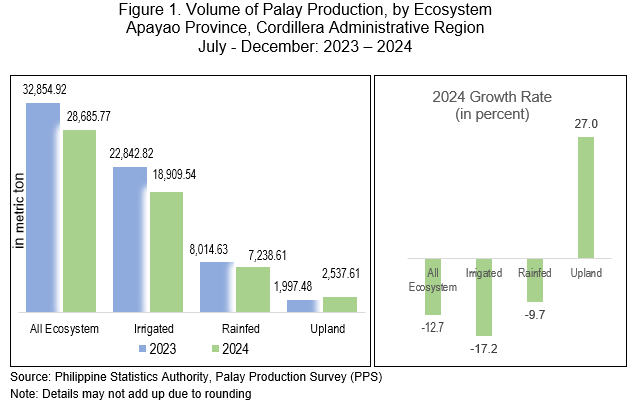
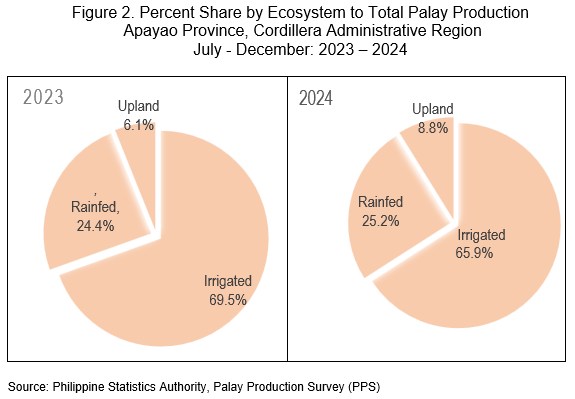
During the reference period, palay produced from irrigated, rainfed, and upland areas accounted for about 65.9 percent, 25.2 percent, and 8.8 percent, respectively. (Figure 2 and Table 1)
The 2024 second semester harvest area at 10,293.19 hectares contracted by 14.0 percent from the previous year’s same period record of 11,973.98 hectares. By ecosystem, irrigated and rainfed areas posted a decrease of 25.2 percent and 3.6 percent, respectively, while upland areas expanded by 280.19 hectares or 16.3 percent. (Figure 3 and Table 1)
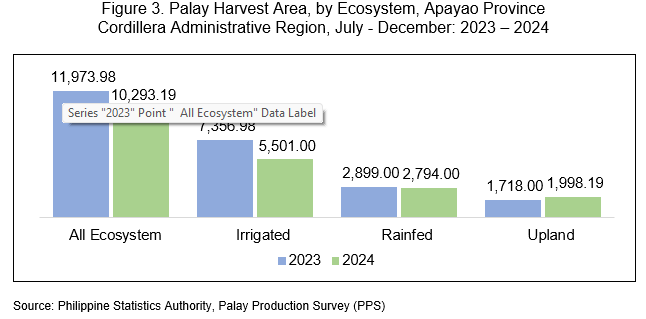
During the period, the average yield per hectare for the aggregate ecosystem inched up to 2.79 metric tons. This was 1.6 percent higher than previous year’s performance. By breakdown, yield improvements were noted for irrigated at 10.7 percent and upland at 9.2 percent. In contrast, a 6.3 percent drop was recorded in rainfed. (Figure 4 and Table 1)
During the period, the average yield per hectare for the aggregate ecosystem inched up to 2.79 metric tons. This was 1.6 percent higher than previous year’s performance. By breakdown, yield improvements were noted for irrigated at 10.7 percent and upland at 9.2 percent. In contrast, a 6.3 percent drop was recorded in rainfed. (Figure 4 and Table 1)During the period, the average yield per hectare for the aggregate ecosystem inched up to 2.79 metric tons. This was 1.6 percent higher than previous year’s performance. By breakdown, yield improvements were noted for irrigated at 10.7 percent and upland at 9.2 percent. In contrast, a 6.3 percent drop was recorded in rainfed. (Figure 4 and Table 1)During the period, the average yield per hectare for the aggregate ecosystem inched up to 2.79 metric tons. This was 1.6 percent higher than previous year’s performance. By breakdown, yield improvements were noted for irrigated at 10.7 percent and upland at 9.2 percent. In contrast, a 6.3 percent drop was recorded in rainfed. (Figure 4 and Table 1)
During the period, the average yield per hectare for the aggregate ecosystem inched up to 2.79 metric tons. This was 1.6 percent higher than previous year’s performance. By breakdown, yield improvements were noted for irrigated at 10.7 percent and upland at 9.2 percent. In contrast, a 6.3 percent drop was recorded in rainfed. (Figure 4 and Table 1)
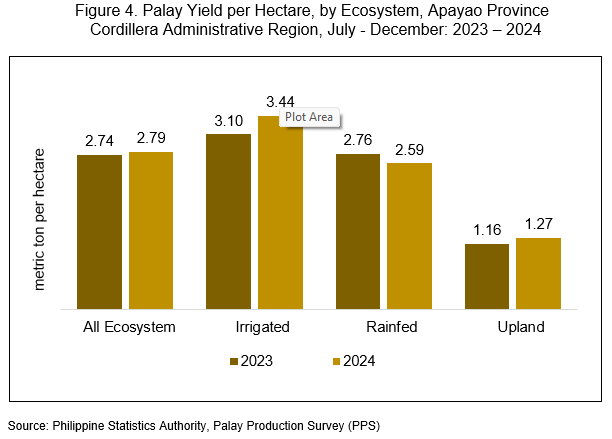
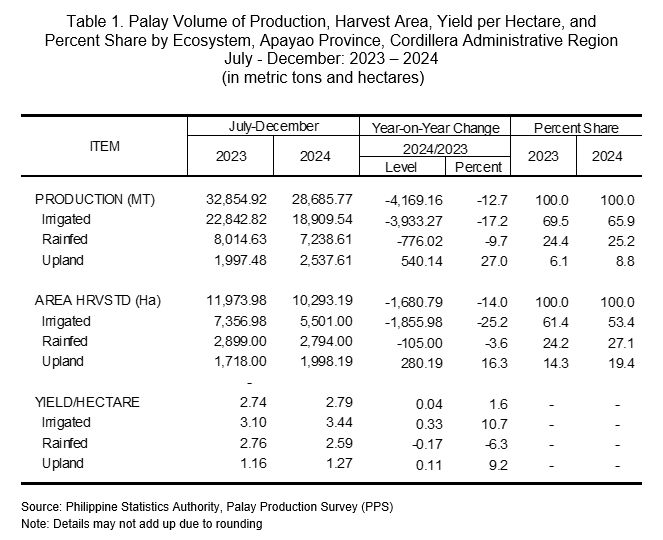
TECHNICAL NOTES
The Palay Production Survey is one of the major agricultural surveys conducted by the Philippine Statistics Authority. This generates estimates on palay production, area, yield, and other production-related data that serve as inputs for policy making and programs on palay/rice. Specifically, the production data generated from the survey are direct inputs to the Value of Production in Philippine Agriculture and Fisheries and to the computation of Gross Domestic Product, accordingly. The data collection covering the last two quarters was conducted during the first 10 days of July and December.
Crop Production - refers to the quantity produced and actually harvested during the reference period. It includes those harvested but damaged, stolen,given away consumed, given as harvester’s and thresher’s shares, reserved, etc. However, it excludes those produced but not harvested due to low price, lack of demand and force majeure or fortuitous events, etc.
Harvest Area - refers to the actual area from which harvests were realized. This excludes crop area that was totally damaged. It may be smaller than the area planted.
Types of Ecosystems - refers to the type of environment where the palay was planted.
- Irrigated - area with irrigation facilities supplying water through artificial means like gravity, force/power, pump, etc. Irrigated area becomes rainfed only when irrigation system is no longer operational for the past two (2) years and beyond repair and there is no plan of irrigating thefarm.
- Rainfed - palay grownon this ecosystemhas dikes that retain water and is solely dependent upon rainfall for its water supply. Rainfed can be converted to irrigated only if area is laid with permanent irrigation facility.
- Upland - palay grownon this ecosystemdo not have amenities for standing water. It is usually located along elevated lands, along rivers, between hills, but also to low areas having no facilities for standing water. Though crops planted in this type of ecosystem are drought-resistant and do not require standing water for their normal growth, irrigation by flushing is sometimes practiced improving the crops’ performance especially during the long dry spell.
Yield - an indicator of productivity calculated by dividing the production data by the corresponding harvest area.
Metric ton - refers to a unit that is being used which is equal to 1,000 kilograms.
Approved by:
GEOFFREY B. CALIMUHAYAN
Chief Statistical Specialist
sgd
/CBB
During the period, the average yield per hectare for the aggregate ecosystem inched up to 2.79 metric tons. This was 1.6 percent higher than previous year’s performance. By breakdown, yield improvements were noted for irrigated at 10.7 percent and upland at 9.2 percent. In contrast, a 6.3 percent drop was recorded in rainfed. (Figure 4 and Table 1)
During the period, the average yield per hectare for the aggregate ecosystem inched up to 2.79 metric tons. This was 1.6 percent higher than previous year’s performance. By breakdown, yield improvements were noted for irrigated at 10.7 percent and upland at 9.2 percent. In contrast, a 6.3 percent drop was recorded in rainfed. (Figure 4 and Table 1)During the period, the average yield per hectare for the aggregate ecosystem inched up to 2.79 metric tons. This was 1.6 percent higher than previous year’s performance. By breakdown, yield improvements were noted for irrigated at 10.7 percent and upland at 9.2 percent. In contrast, a 6.3 percent drop was recorded in rainfed. (Figure 4 and Table 1)During the period, the average yield per hectare for the aggregate ecosystem inched up to 2.79 metric tons. This was 1.6 percent higher than previous year’s performance. By breakdown, yield improvements were noted for irrigated at 10.7 percent and upland at 9.2 percent. In contrast,
